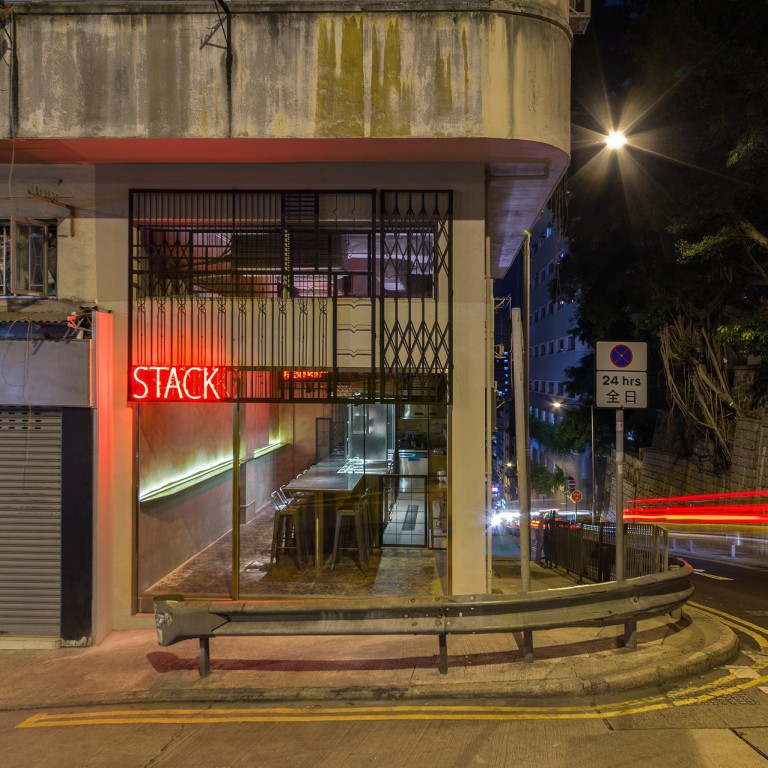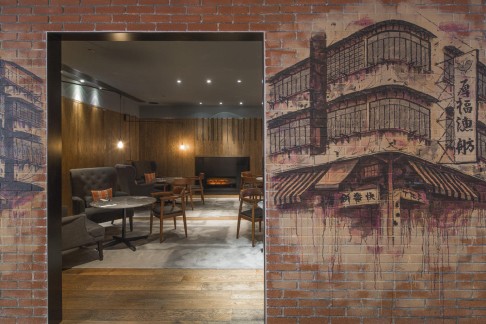
Designers take from the past for the city's future
Designers take a step back in time in search of fresh ways to conjure up old Hong Kong, writes Christopher DeWolf
When the restaurateur Josh Ng Pak-kei and his twin, Caleb Ng Pak-wah, were looking for someone to design the interior of their latest venture, a Sai Ying Pun pancake and cocktail bar called Stack, they wanted something rooted in Hong Kong.
"You can see there are a lot of architecture and interiors that are copying different styles from New York," Josh says. "I was thinking, 'Why can't we do something that really represents Hong Kong?'"
We don’t just duplicate old Hong Kong; it’s transformation of the old into new
It was a mission that seemed especially important in Sai Ying Pun. The impending arrival of the MTR has sparked a boom in new bars, restaurants and shops in the hillside neighbourhood, many of them indistinguishable from those found in SoHo - whether that be Hong Kong, New York or London.
It's a similar story in other neighbourhoods, where rising rents have driven out many old shops and restaurants, along with their decades-old decor. And while designers such as Douglas Young, founder of lifestyle brand G.O.D., have successfully replicated elements of Hong Kong's vernacular design in projects such as Starbucks' bing sutt corner in Duddell Street - evoking the city's old-style cha chaan teng - others are asking themselves how to recall Hong Kong in a more contemporary way.
"We've been struggling with this issue for some time," says Wilson Lee, director of Wall Studio, which the Ng brothers hired to design Stack. "We don't want to just duplicate the patterns and design of old Hong Kong because that doesn't relate to the culture of Hong Kong nowadays. It has to be about the transformation of the old elements into something new.
"If you just copy something from the past and focus on the outlook, the spirit and meaning behind it is gone."
For Lee and his partner, Alex Siu, Stack was a chance to explore what it meant to design a Hong Kong-style environment. They might have felt constrained with a floor area of only 300 sq ft, but had an intriguing starting point - original 1960s floor tiles, which are one of the most easily identifiable aspects of the Hong Kong vernacular.
"You can't find anyone to make them any more, not in Hong Kong, not in China," says Lee. To contrast the warm hue and scuffed texture of the tiles, he and Siu created a long, sleek aluminium table. They also designed a string of neon text to cast a cinematic glow over the restaurant, and sculptural metal screens evoking the iron window frames and security gates found in many Hong Kong apartments.
Those iron-framed tong lau window frames are another distinctively local design feature.
"Iron windows and doors were so commonly a part of Hong Kong, mid-20th century life it is enough just to reinstall them to reflect a strong part of Hong Kong's character," says designer Andrew Bell. "Even if it is the only thing you incorporate, it says Hong Kong."
Since 2006, he has worked on dozens of tong lau renovations on Hong Kong Island. "My first clients were among the first entrepreneurs buying tong lau and restoring them," Bell says.

Six years ago, Bell was restoring a now-demolished tong lau flat on Shelley Street when he noticed an unusual pattern in one of the decorative window grilles - a kind of circular joint between bars, like a safety pin stretched flat.
"I have since seen another original version only once, in the back windows of another tong lau in the depths of Sheung Wan. So I decided to adapt that pattern for the total restoration, and I have used it in many other restorations, bringing back to life a rare piece of tong lau history."
Perhaps more than any individual architectural element, however, what counts is a specific sense of place.
"We have to understand the essence of the place, space and typology so we do not resort to just putting [in] decorative elements to give one a sense of the past," Shanghai-based architect Lyndon Neri says. "If we do, we are no different from Disneyland, which has a place in society for entertainment purposes, but definitely not for the everyday."

One feature of the Pentahotel is a first-floor lounge and dining area that reminds guests of Hong Kong's dai pai dong, with a hawker stall-like open kitchen. "We tried to celebrate the everyday, the mundane and the ordinary of Hong Kong street life," Neri says.
That was also the case for Mott 32, a Cantonese restaurant designed by Joyce Wang. Occupying a sprawling space in the basement of the Standard Chartered Bank Building in Central, the venue contains several distinct spaces that bring to mind different aspects of the city's history and identity. "We retraced Hong Kong's history from the 1900s, the Sun Yat-sen era and British colonialism, Hong Kong as a fishing village, and what it is today and what traces those eras left behind," Wang says.
Her design makes use of tiled floors and vintage posters, but also more oblique references to Hong Kong, such as copper cables, woven together like silk, and Asian-style furniture designed by Westerners, such as Cleo Baldon. "It comes from a very personal perspective of what Hong Kong is, or what China is, as opposed to really going to search after its history.

One of the first to search for a uniquely Hong Kong aesthetic was G.O.D.'s Young. In 2009, he was commissioned by Starbucks to design the bing sutt corner, featuring green metal window frames, hanging birdcages and colourful decor, reminiscent of early post-war cafes.
In 2012, he and Stanley Wong Ping-pui collaborated on another Starbucks design for a shop in Argyle Street, Mong Kok, with a wall made of mahjong tiles and a section inspired by old Hong Kong cinemas.
Although the designs have been popular - the bing sutt corner is a tourist attraction - they have also been greeted with rolled eyes and criticism. Young still bristles at being called "the king of kitsch" in 2009 by columnist Andrew Sun.
"I think it's terribly unfair for Hong Kong-style to be labelled 'kitsch' when we try to pay homage to our design heritage," he says. "Why is it, when Western designers like Philippe Starck incorporate an ornate crystal chandelier into a bar, it's not called kitsch?"
Young says "a change of attitude" is needed towards Hong Kong style. "As Hong Kong people, if we so instinctively denigrate our own design heritage, we shall never gain the respect of the outside world."
Wang says good spaces must embody the city's spirit more than its style. She points to Andre Fu's The Upper House hotel, along with the Asia Society Hong Kong Centre, designed by Tod Williams and Billie Tsien, as examples of distinctively Hong Kong buildings.
"In The Upper House there's a celebration of craft in the way the details of the wood are done, but not in the sense that it feels like it's too rustic," she says.
"Hong Kong isn't rustic. Things are a bit finished, and The Upper House is finished, but has that Zen quality to it without feeling Japanese."
For Wall Studio, the most important way of channeling the Hong Kong spirit is to make sure each design is rooted in the community. Stack's metalwork and neon signs were made by local craftsmen. "We know they have the experience - they've been handling these elements for many years," Lee says.
"We need their input to tell us why these things exist the way they do. It's like a collaboration - we inject our ideas and they inject their skill."
Josh Ng says that this philosophy will guide his future endeavours. "These are my roots," he says. "When you design a project you have to connect to it, to express something from your heart."

